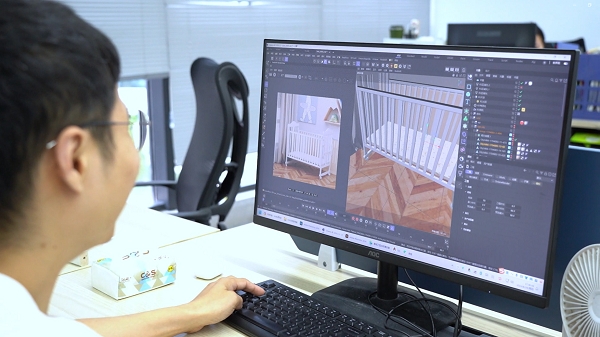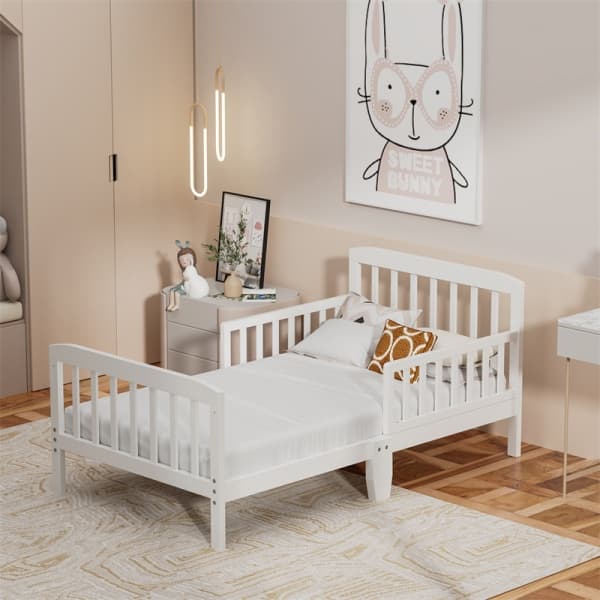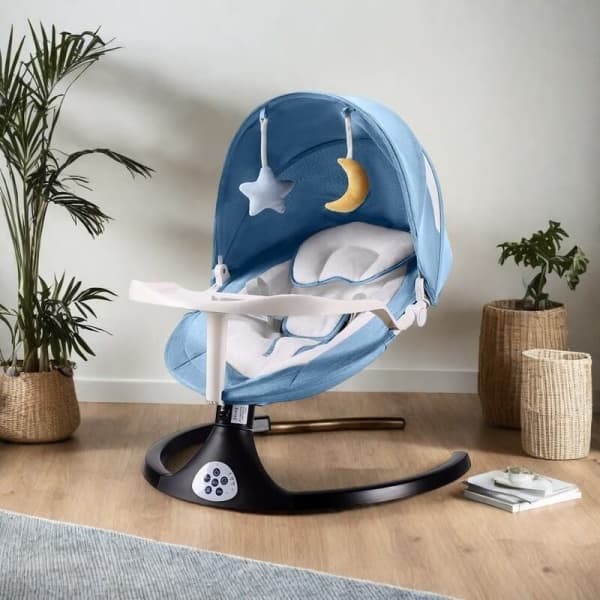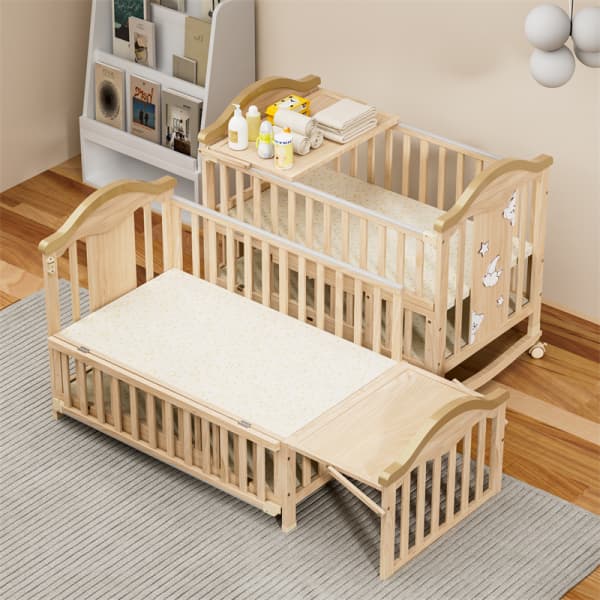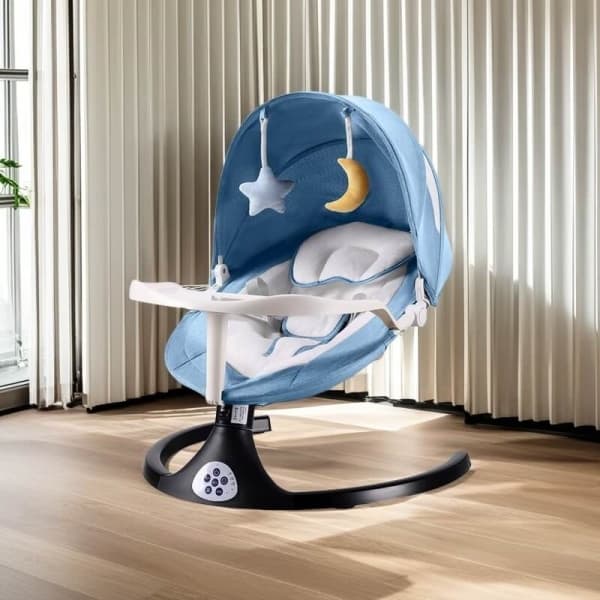Picture this: You’ve spent 45 minutes swaying, shushing, and bouncing your newborn into what finally seems like deep sleep. You tiptoe to the bassinet, lower them gently onto the mattress…and bam—eyes pop open, arms flail, and the wailing begins.
If this feels achingly familiar, take a breath—you’re not failing. Newborns are fresh from a warm, noisy, ever-moving world where “sleeping alone on a flat, still surface” wasn’t part of the job description.
With science-backed tricks and a hefty dose of patience, you can help your baby adjust—without ditching safe sleep rules (or your last shred of sanity). Let’s start by understanding why newborns won’t sleep in their bassinet—and why it doesn’t mean you’re doing anything wrong.
Is It Normal for a Newborn to Refuse the Bassinet?
Short answer: Absolutely. Studies show nearly half of newborns fight bassinet sleep at first.
Your baby spent nine months in a snug, dark, 24/7 sound bath—curled up, swaying with your movements, and surrounded by the rhythmic thump of your heartbeat. Suddenly, they’re thrust into a vast, quiet, motionless space. To a newborn, a bassinet can feel like sensory whiplash.
Dr. Harvey Karp, pediatrician and author of The Happiest Baby on the Block, explains: “Newborns aren’t ‘rejecting’ the bassinet. They’re biologically programmed to seek closeness, motion, and warmth—survival instincts that kept them safe in the womb.” Resistance isn’t a sign of stubbornness; it’s a reflection of their neurological wiring.
But here’s the key: This phase is temporary. Most babies adapt to bassinet sleep within 2–6 weeks as their nervous systems mature and they adjust to life outside the womb. Until then, your job isn’t to “fix” them—it’s to bridge the gap between their instincts and safe sleep guidelines.
While common, bassinet refusal can be emotionally grueling for parents. Sleep deprivation clouds judgment, and the pressure to follow AAP guidelines (“back is best, alone in the bassinet!”) can feel overwhelming when your baby screams the moment they’re laid down.
But here’s the paradox: Your baby’s resistance is a healthy sign. It means their startle reflex, sensory awareness, and attachment instincts are intact—all critical for survival.
Why Does My Baby Wake up as Soon as I Put Her in the Bassinet?
Gently placing a sleeping baby into the cradle is a relaxing moment that parents look forward to, but many parents find that their children always wake up suddenly at this time. This is a characteristic of infants’ physiological needs and environmental adaptability. Here are several possible reasons and suggestions for coping:
“Sense of Security Gap” Caused by Environmental Changes
When the baby is in the arms of his parents, he can feel the body temperature, heartbeat, and familiar body odor, which will bring a sense of wrapping similar to the womb environment. When transferred to the cradle, the difference in body temperature, the disappearance of the sense of support, and the increase in the openness of the space may trigger the baby’s alert response.
The Startle (Moro) Reflex
Your baby’s nervous system is still learning to navigate gravity. When their arms suddenly flail mid-transfer, it triggers a primal “falling” sensation hardwired for survival. This reflex peaks around 6–8 weeks and can jolt even the sleepiest newborn awake. Think of it as their internal alarm system—loud, jarring, and totally normal.
Temperature Shock
Your arms radiate warmth (about 98.6°F), while most bassinet mattresses start at room temperature (68–72°F). That 15–20°F drop can feel like plunging into icy water for a baby whose body struggles to self-regulate.
Positional Discomfort
In the womb, your baby was curled in a tight ball. A flat bassinet mattress stretches their limbs into an unfamiliar, sprawling position—a sensory mismatch that screams, “This isn’t right!”
Transition Between Deep and Light Sleep Cycles
Infants and young children have shorter sleep cycles than adults, and they experience deep and light sleep alternations every 20 minutes. If you move your baby during the light sleep stage, slight changes in body position (such as changes in the head angle) or slight shaking of the cradle may disrupt the sleep balance.
Each baby has a different level of sensitivity, and these reactions are essentially adaptive exercises to the new environment. With the development of vestibular and proprioceptive senses, most babies will gradually adapt to independent sleep after 4-6 months.
If frequent awakenings are accompanied by refusal to eat and continuous crying, it is recommended to consult a pediatrician to eliminate health risks.
What to Do if Your Newborn Hates the Bassinet?
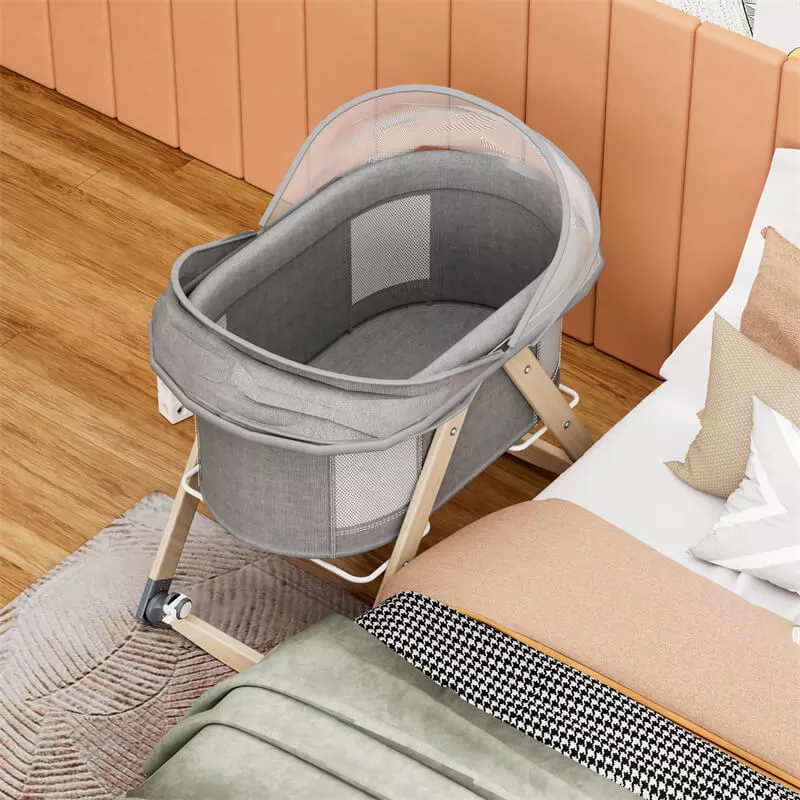
Hack the Environment
Pre-Warm the Mattress: Use a heating pad or hot water bottle for 10 minutes (remove it before placing the baby!). The goal: mimic your body heat.
Layer Your Scent: Tuck a worn T-shirt or muslin blanket under the bassinet sheet (away from baby’s face). Your smell = built-in comfort.
White Noise Wizardry: Use a machine (or app) set to low-frequency sounds (e.g., rain, womb noises). Place it under the bassinet—vibrations simulate uterine movement.
Swaddle Like a Pro
Not all swaddles work for all babies. Test these options:
Arms-Up Swaddles: Let babies self-soothe by nuzzling their hands.
Weighted Swaddles (AAP-approved only): Light pressure mimics your touch. Avoid weighted products unless cleared by your pediatrician.
Double-Swaddle Method: Layer a stretchy wrap under a sleep sack for extra containment.
Master the Transfer
Wait for the “Flop”: Look for limp arms, steady breathing, and a slack jaw—signs of deep sleep.
Slow-Mo Lowering: Lower butt-first, keeping your hands firmly on their chest and hips for 30 seconds. Gradual pressure withdrawal prevents the “falling” sensation.
The “Drowsy but Awake” Myth: If your baby screams when laid down drowsy, ditch this advice. For some newborns, full sleep is non-negotiable.
Bassinet Alternatives (When All Else Fails)
Co-Sleeper Bassinets: It can attach to your bed, letting your baby sense you without bed-sharing.
Portable Cribs: It folded smaller than most bassinets.
Contact Naps by Day: Use a baby carrier for daytime sleep while practicing bassinet time at night.
Other Reasons Why Newborns Don’t Want to Sleep in the Bassinet
While reflexes and environmental factors often take center stage, there are lesser-known culprits that might explain your baby’s bassinet resistance. Let’s dig deeper:
Silent Reflux
Unlike typical reflux, silent reflux doesn’t involve visible spit-up. Instead, stomach acid creeps up the esophagus, causing a burning sensation when your baby lies flat. Signs: Arching their back mid-sleep, frequent hiccups, or a hoarse cry.
Fix: Ask your pediatrician about a 10-degree incline (approved by the AAP for reflux). Use a wedge under the bassinet mattress—never prop your baby directly on pillows.
Overstimulation
Newborns process sensory input in short bursts. A brightly lit room, loud household noises, or even a vibrant mobile can overload their nervous system, making sleep impossible.
Fix: Use blackout curtains and a red-spectrum nightlight (less disruptive to melatonin). Keep interactions during nighttime feeds boring. No eye contact, singing, or play.
Hunger-Clock Confusion
Newborns lack circadian rhythms. If they cluster-feed during the day or nap excessively, they might “reverse cycle”—sleeping all day and treating nighttime like a buffet.
Fix: Offer feeds every 2–2.5 hours to stockpile calories.10 minutes of indirect morning sunlight helps reset their internal clock.
Undetected Discomfort
Immature digestion can cause trapped air when lying flat. Try a pre-sleep bicycle leg massage. Some babies hate the bassinet’s fabric texture. Test a bamboo or organic cotton sheet.
Checklist
When the baby resists the cradle, check in the following order:
1. Diaper moisture ▶ Body temperature ▶ Skin condition ▶ Abdominal softness
2. Environmental noise ▶ Light intensity ▶ Air circulation
3. Last feeding time ▶ Whether there is burping/farting
Special reminder: If the baby has the following conditions, you need to seek medical attention in time:
- Continuous refusal to feed for more than 6 hours
- Crying accompanied by vomiting green liquid
- The fontanelle is obviously bulging or sunken
- Limb stiffness or softness
How to Get a Newborn to Sleep in a Bassinet?
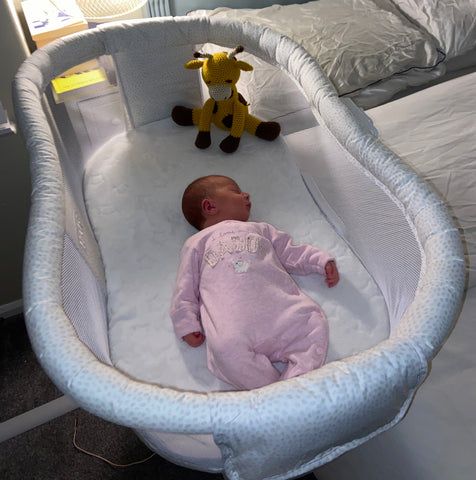
Newborns need to adapt to independent sleep through both physiological regulation and environmental adaptation. The following strategies combine the laws of infant development to help babies establish a sense of security and comfort in cradle sleep in stages. It is recommended to flexibly adjust the rhythm according to the baby’s response:
Simulating the Womb Experience from the Sensory Dimension
The sensory system of newborns is much more sensitive to temperature, touch, and sound than adults. When preparing a cradle, you can focus on creating a triple buffer layer:
1. In terms of touch, use pure cotton clothes worn by the mother to lay the mattress. The softness of natural cotton fibers and residual body odor can awaken the baby’s memory and sense of security.
2. In terms of hearing, turn on the white noise device that simulates the sound in the womb in advance, and control the volume below 50 decibels (approximately equal to the sound of shower water). Studies have shown that continuous low-frequency background sound can reduce the baby’s heart rate by 11-15 beats/minute.
3. Temperature regulation requires fine control. First, use a 40℃ hot water bottle to preheat the mattress for 10 minutes. After taking it out, ensure that the contact surface temperature is maintained between 32-34℃ (close to the mother’s abdominal temperature). Use an infrared temperature gun to detect and avoid local overheating.
Determining the Best Time to Fall Asleep
The key to successfully transitioning to sleep is to grasp the “sleep window period”. Newborns will enter their first sleep cycle 45-90 minutes after being awake, when the body begins to secrete melatonin.
Parents need to closely observe the early signs: when the baby’s eyes become empty, the blinking frequency drops from 20 times per minute to less than 5 times, and the spontaneous movements of the hands and feet decrease; these signals indicate that the nervous system is switching to rest mode.
If you wait until obvious sleepiness signals such as yawning and rubbing eyes appear, the baby’s cortisol level may have begun to rise, making it more difficult to fall asleep.
It is recommended to start the sleep program when early signals appear, using the “four-step progressive method”: first adjust the indoor light to dusk-like dimness, then wrap the baby with a swaddle (note that the upper arms are wrapped slightly tightly and the lower limbs keep the frog legs in a natural position), then pat the back at a frequency of 1 per second, and finally hum a lullaby with a fixed melody. This multi-sensory synchronous comfort can effectively lower the awakening threshold.
Step-by-Step Transfer Techniques
Transferring from arms to cradles requires precise body control. Correct operation is divided into three stages:
1. In the deep sleep confirmation stage, gently pull the baby’s wrist to observe whether the “arm drop test” occurs – if the arm falls naturally without reaction, it means entering the third stage of non-rapid eye movement sleep.
2. In the transfer execution stage, use the “three-point support method” – the left hand always supports the back of the neck to maintain the midline of the head and neck, and the right hand first places the buttocks to touch the mattress, and then slowly flattens the upper body after 3 seconds of adaptation. The whole process keeps the baby’s body axis tilt angle less than 15 degrees.
3. In the withdrawal consolidation stage, when withdrawing the arm, use the warm palm to continuously press the chest lightly, and gradually turn the humming sound into the white noise of the player. This sensory relay can reduce the stimulation caused by sudden changes in the environment.
Targeted Strategies for Different Ages
0-6 weeks focus on replicating the uterine environment. You can use a gravity sleeping bag – sew a small bag filled with buckwheat husks at the bottom of the swaddling cloth, and simulate the feeling of being wrapped in amniotic fluid through a continuous pressure of about 0.5kg.
Vestibular stimulation can be introduced at 6-12 weeks, such as holding the baby upright before going to bed to do “pendulum exercise”: with the hip as the axis, slowly tilt 30 degrees to the left and right, and the frequency of 8-10 times per minute can promote the development of the inner ear balance system and prepare for adapting to the rocking of the cradle.
After 3 months of age, the baby begins to have the ability to soothe himself. At this time, a “soothing towel” can be placed in the corner of the cradle – the breast pads during breastfeeding are sewn into pure cotton gauze. The familiar smell combined with the graspable edge of the fabric can help the baby realize self-soothing when waking up at night.
Avoiding Common Misunderstandings
Over-reliance on rocking: Mechanical rocking beds should be used continuously for ≤20 minutes at/time to prevent overstimulation of the brain.
Frequently changing strategies: New methods need to be tried for 3-5 days before evaluating the effect.
Ignoring the difference between day and night: Avoid eye contact and conversation when falling asleep at night, and use monotonous movements to maintain a sleeping atmosphere.
Premature sleep training: Before 4 months of age, the focus should be on meeting needs. Forced training may damage trust.
Conclusion
The bassinet battle might feel endless at 2 a.m., but remember: This phase is a blip in your parenting journey, not a life sentence. Every baby adapts on their own timeline—some within days, others over weeks—and your job isn’t to “fix” them, but to gently guide them toward safe sleep.
The bassinet isn’t the enemy. It’s a bridge—one that connects your baby’s primal needs to the reality of life outside the womb. With patience, creativity, and a few pre-warmed mattresses, you’ll cross it together.
Recommended Related Articles:
- Bassinet Vs Moses Basket: Which One Should You Choose?
- Bassinet Weight Limits: What You Need to Know
- What to Look for in a Bassinet?
- Bassinet Vs Crib Vs Cradle: Which Should You Choose?
- What Is a Co Sleeper?
- Co-Sleeper vs Bassinet: Which Is Right for Your Baby?
- Baby Travel Bassinets: The Ultimate Guide
- Understanding Bassinet Safety Standards of 2025

